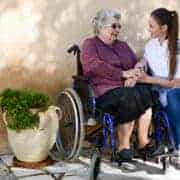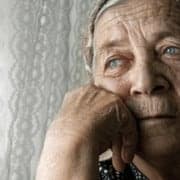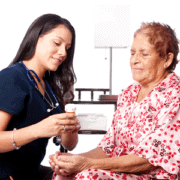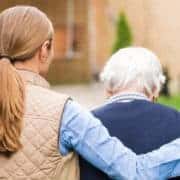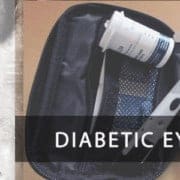Talking to Residents with Dementia / Alzheimer’s
In our previous blog, Assisted Living Education addressed how to effectively interact with elderly residents. In this blog, we discuss specifically how to better interact with residents diagnosed or presenting symptoms of dementia or Alzheimer’s.
Although the Journal of American Medical Association (JAMA) reports that overall incidence of dementia has declined from 11.6% in 2008 to 8.8% in 2012, it is still one of the most common conditions we see in assisted living. This is largely because people with the condition can no longer live independently, and it can be quite demanding to care for someone with dementia/Alzheimer’s at home, especially if they have dual or multiple illness diagnoses.
Since people with dementia can have a delicate cognitive or behavioral disposition, here are some useful strategies in aiding interactions with residents who may have dementia or Alzheimer’s.
Help Guide the Interaction
Because dementia can leave residents with cognitive deficits, make sure the resident is focused on you when interacting with them, and vice versa. You may want to gently place a hand on their shoulder or arm and look directly at their face while speaking their name in order to ensure you have their full attention. Maintain eye contact, again, so you know they are focused on you. Avoid giving instructions or chatting in places with ambient or sharp noises, as those can be distracting and confusing for the resident.
Our previous blog, Respect Your Elders: How to Effectively Interact With an Elderly Resident also provides some great generic tips as well.
Managing and De-escalating Outbursts
Much of a resident’s executive cognitive functioning is lost to dementia as the condition progresses. This includes losing capabilities such as extended thought processes and coping skills. Their mood and disposition may change because their coping mechanisms and thought processes have deteriorated, in addition to an increase in confusion.
Delusions, Paranoia, & Hallucinations
Some residents with dementia may have delusions and paranoia as well. When a person with an average mind cannot entirely remember something, their mind attempts to fill in the gaps with information. In individuals with dementia, this is especially true, although the information filled in is often grossly incorrect, even though it might make sense to them. Sometimes this can lead the resident to false conclusions, such as pairing the arrival of a staff member with the arrival of darkness (night time), and thinking that the staff member hides the sun, for example.
Sometimes in the later stages of the disease, residents may experience hallucinations. This is a result of the changes occurring in the deteriorating brain. More often, hallucinations are seen in residents with Dementia with Lewy Bodies or even Parkinson’s Dementia, but also those with Alzheimer’s as well.
Be sure to distinguish between a hallucination and a delusion: A hallucination is seeing or hearing something that is not actually occurring, and a delusion is a false belief usually derived from paranoia or suspicious feelings.
Further, be careful to distinguish a hallucination from poor eyesight. Poor eyesight can make the resident think they are seeing something, and with decreased cognitive capacity, they may not be able to deduce that what they think they are seeing is incorrect. For example, strange shadows may appear to be a monster or creature, and a shiny floor could appear wet. Make sure the resident’s eyesight has been checked recently, schedule them for an appointment, or make sure they are wearing the proper lenses before assuming they are hallucinating.
Useful Strategies & Phrases
It is pointless to argue or offer logical/lengthy explanations to a resident with dementia. They may no longer possess the cognitive capacity to understand or make sense of what you are saying. Instead, the following strategies and tips can help get through a challenging conversation.
Validate their Feelings and Provide Reassurance
It is helpful to validate their feelings and keep things simple. Be compassionate and build that trust with them; this can help keep things calmer and de-escalate a situation. If they are upset over a lost item, offer to help them find it. Avoid negativity on your side of the conversation; keep it neutral or positive. Instead of, “Don’t you remember? You always keep it in your drawer!” or “Why do you always lose things?” try encouraging and reassuring statements, “Let’s have a look in your drawer,” or, “I’m sure it’ll turn up, let’s just have a look around.” If there are items that seem to be misplaced frequently, it might be wise to keep a spare on hand, just in case.
Additionally, if accusations arise and are directed against you, don’t take it or make it personal. The resident is often caught up and reacting to their present upset state and might direct emotions at you simply because you are there, or you’re someone they see frequently.
Divert their Attention
Some situations may benefit from a diversion. For example, if a resident begins saying or doing inappropriate things, instead of chastising them, a better solution can be to divert their attention. Unlike the average person who can be taught or socialized to what is/is not appropriate language or behavior, these cognitive faculties have been altered beyond learning and understanding consequence. Impulse control has deteriorated. Try broaching a completely different topic, “Do you know who’s playing Super Bowl this year?” or, “Let’s get ready for lunch.”
This can also help in situations which are threatening to escalate, in an attempt to take their mind off the present problem. Engage them in an activity they enjoy, such as singing or dancing: “I heard my favorite song on the radio the other day…” but choose a song you know they’re familiar with so they can join in. Music and song are unique anomalies that seem to be spared from the grasp of dementia; it can bring back memories and musical skill ingrained in an individual.
Keep it Positive or Neutral
Nobody enjoys hearing, “Don’t do that!”, “Don’t go there!”, “Stop doing that!” or other negatively commanding phrases. Residents with dementia are no different. In fact, these kinds of phrases can frustrate and possibly agitate a resident and escalate into further problems.
| Instead Of … | Try… |
| “Don’t do that!” / “Stop!” | “Let’s try this instead…” |
| “Don’t go there!” | “Let’s go this way.” |
| “Relax, calm down!” | “Let’s take a break.” |
| “That’s wrong!” / “No, not like that!” | “Here, let me help you.” |
| “Hurry up!” | Anticipate and verbalize the next step. “Do you need your shoes?” |
| “Don’t you remember? You put it away.” | “I thought we put it in your drawer. Let’s check.” |
| “Remember? Like this.” | “This is how we stretch before exercise.” |
Use gentle reminders and keep your tone neutral and positive. Be specific when you can and use familiar words, but keep your phrases simple. Additionally, it can be useful to phrase things in a way that suggests working together, instead of you always having to help or do it for them. This can help an individual feel that they are not completely dependent, thus improving/maintaining their self-esteem and dignity.
Keep In Mind …
These residents are adults and many of them were fully-functioning, independent people at one point in their lives. They may even have had an established or esteemed career and held highly respected positions, or they may have been masters at their trade or craft for years. Maybe they were the driving cornerstone of their family, and still are, but with fewer capabilities. Their newer, dementia-shrouded world is confusing, scary, and can be nonsensical. It is difficult at times for the resident (and others) to cope with this degenerative condition. Any anger or frustration may sometimes derive from not being used to this new dependence on others, or not being able to perform basic tasks as they used to in the past.
Make sure to keep that in mind and even help family members understand if they seem to have difficulty as well. First, consult with your supervisor or head of the facility to ensure that this conversation is permissible, or what specifically is allowed in conversation with family members, friends, or conservators of the resident.
Assisted Living Education is a premier provider for assisted living services, education, and educational resources. We offer RCFE courses & certification, as well as online courses and continuing education. Our instructors have extensive experience in the field and are known for making their classes highly engaging and practical. Explore our website, or visit our contact page to reach out to us personally!


